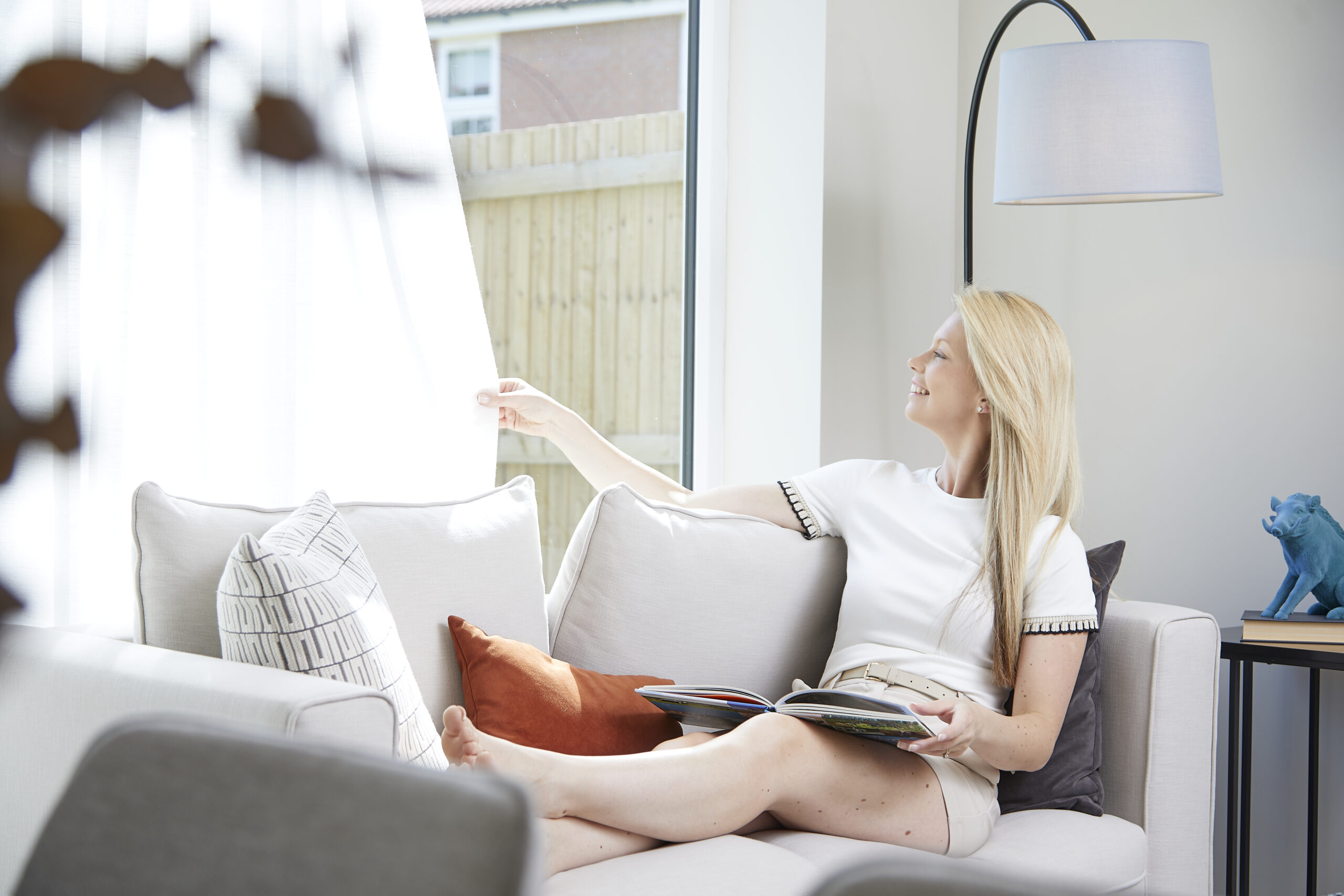Let’s face it, sunlight comes at a real premium if you’re living in the UK! Therefore, harnessing it and maximising it wherever possible seems like a great idea, especially in your home.
Increasing the amount of natural light reflecting around your home is not only a key feature of creating an inviting, welcoming and airy space, but it can also help us to feel happier, reduce our energy bills and even improve our health too!
So, how can we make it happen?
Well, despite every property being unique in terms of its position towards the sun, its size and its architecture, there are some universal concepts that can be used to help maximise light in any home. And, many of these require minimal investment too.
If you want to fill your home with more natural light, then our 8 top tips are a great place to start….
Opt for light-coloured walls & ceilings
If you’re looking to create a lighter and brighter home, then softly-coloured walls and ceilings are a must. While dark colours absorb light, pale colours reflect it, helping to scatter light around the room from all angles.
And, although bright whites might seem like a good choice for light reflection, they aren’t always the warmest of shades, so opting for earthier tones of cream or light beige can help to create that sense of natural light, but keep things warm and cosy at the same time.
Another helpful tip is to opt for gloss paint instead of matte if you are trying to reflect more light around the space. The glossier your walls are, the more light will be reflected. If you aren’t a huge fan of gloss paint, then semi-gloss alternatives are available for a subtler effect.
Choose reflective flooring & surfaces
We know that dark coloured walls and ceilings create darker spaces, and the same rules apply to flooring and surfaces too.
Gloss tiles, polished-effect wood/laminate and light-coloured carpets are all perfect flooring types for reflecting light and adding brightness, however, if you have a busy household with children and pets, then these might not always be the most practical of options!
Therefore, you can always look to your kitchen and worktop surfaces to provide the reflection instead. Lightly-coloured granite, marble or quartz can provide beautiful reflective surface materials that are also hard-wearing and easy to maintain. Just as with the paint effect, the more glossier the surface finish is, the more natural light will bounce off it and around your kitchen.
Decorate with mirrors & reflective accessories
A simple, low investment way to pull in more light and focus it into specific areas is with the use of wall mirrors. When positioned in the right places and angles, mirrors can be the most effective way to create the illusion of a larger, lighter space – and they reflect sunlight that would otherwise be absorbed into walls and furniture.
If you have a large window, then hanging a large mirror opposite it is a great way to make the most of the natural light available by attracting it in and bouncing it over to other areas of the room. If you have a small space and want to give the illusion of more space, then positioning a mirror here will work wonders. Mirrors come in all shapes and sizes, so opt for those that are on the larger side and that are framed with lightly-coloured frames that aren’t too thick or overbearing. You can often pick up lovely mirrors relatively cheaply from hardware stores, antique shops or local markets.
In addition to wall-hanging mirrors, there are other ways of using reflective accessories around your home. Mirrored furniture, like wardrobes or tables are great for light reflection, as well as mirrored trays, pedestals and sculptures, which will create amazing and unique shapes with light reflection.
Rearrange your furniture
If you already have furniture of your own, it won’t always make good financial sense to replace it with newer, lighter alternatives, but the good news is that you can still bring in more light into your home by simply moving around what you’ve already got.
To begin, take a look around your home and assess whether you have any large, bulky furniture pieces that are close to windows, doors or mirrors. If so, try to find them a new position in the room so that they aren’t blocking out so much light that would otherwise be free to travel around the room.
Also, assess whether you really need all the furniture that you already have in a room. Too many items of furniture can make rooms feel dark and cramped, so if you are able to make some extra space by selling a specific item or giving it to charity, then you are sure to notice a difference in terms of light in the room.
Use a soft palette for soft furnishings
Soft accessories such as rugs, cushions, blankets, and throws can all make a huge difference in adding splashes of light colour – even against large furniture pieces that are dark and heavy.
A pale throw and some pale cream scatter cushions on a dark sofa will add instant light without costing the earth, just like a large lightly-coloured rug on top of a dark wood floor.
Go light with window dressings
Your windows are a key ingredient in your quest to attract more light into your home and heavy curtains and blinds could be stopping this from happening!
Whilst you also have to consider privacy and warmth in the winter months, window dressings shouldn’t be a reason for your rooms feeling dark and light-less.
If you’re opting for curtains, then avoid heavy fabrics like velvet or brocade, and replace them with light, cotton or linen options that are easier to draw back to the sides in the day without blocking the windows. Be sure to get tie backs to attach to the walls which will keep the curtains pulled back throughout the day before it’s time to draw them closed again at night.
Blinds often provide a simpler option as they can be completely rolled up during the day with minimal light blockage, or down at night to provide complete privacy. They are often more cost-effective options too and come in a wide range of fabrics, colours and patterns.
Top up with artificial light
Even though we are looking at ways to increase natural daylight at home, artificial lighting can be used to enhance and complement it. It’s also an excellent option for windowless spaces and darker areas of your home where the natural light doesn’t reach. Artificial lighting can be very effective at lighting up awkward areas like alcoves, corners, corridors and book shelving too.
There are three main types of artificial light. These are ambient lighting such ceiling lights, floor lamps and spotlights that diffuse light evenly throughout the room, accent lighting, such as table lamps, fairy lights, and wall light accessories that add depth and atmosphere to a particular area, and task lighting that is used for specific tasks, like a desk lamp on a workstation or lights over the oven in your kitchen.
Depending on the size of your room and the amount of natural light in it, you won’t always need to incorporate all three forms of lighting, but it’s helpful to incorporate a range of each type of lighting to add different light types at different areas.
Wash your windows!
And finally, a small but very important tip – always keep your windows clean!
Dirty windows can dramatically reduce the amount of light entering your home, so making sure both your indoor and outdoor windows are regularly washed and wiped will help sunlight to enter in through the glass and brighten up your home!
Looking for a cheap and natural way to clean your windows? Mix two parts water with one part white vinegar in a spray bottle and you’ll be all set with a homemade cleaner to get those windows as sparkling as ever!
Be sure to check out our other Peter Ward Homes blog articles for advice and inspiration on bringing joy into your new home.




